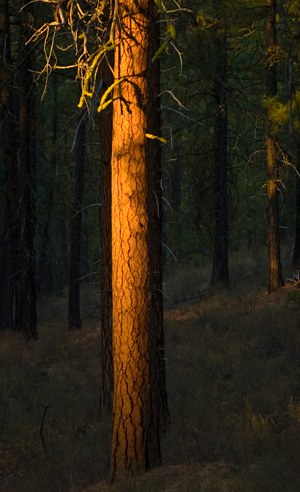In preparation for the Land Trust's Nature Night on Megafires, we offer a primer on east Cascade dry forests and their historic conditions. Thanks to The Nature Conservany forest ecologist Kerry Kemp for this guest blog!
Dry forests composed of large ponderosa pine and other fire-tolerant species once dominated the foothills east of the Cascades. These forests stretched from Klamath Falls to Warm Springs, and east to John Day, La Grande, and Enterprise. Surface fire was a frequent visitor to these forests, ignited by lightning or Native people leaving their summer hunting grounds in the fall. As the fire spread gradually across the forest floor it consumed litter, shrubs, small patches of seedlings, lower branches of large trees, and the occasional bigger tree.

Beginning with Euro-American settlement late in the 19th century, conditions in the forest began to dramatically change. Grazing eliminated the grasses, flowers, and other small plants that grew in abundance and helped spread low-intensity surface fires across the forest every few years.
By the early 20th century, humans started putting out the fires that would have spread under moderate weather conditions. The lack of regular, low intensity fire combined with favorable climate conditions mid-century resulted in an explosion of seedlings. Shade-tolerant tree species like grand fir, which historically would have succumbed to those frequent fires, filled in the gaps, creating dense, over-crowded forests. Finally, selective logging of the largest and oldest trees simplified the forest, leaving it full of similarly aged trees.
As a result, the dry forests of Eastern Oregon that thrived in centuries past are now extremely vulnerable to larger and more intense wildfires, expansive bark beetle outbreaks, and drought, all fueled by a warming climate.
Luckily, effective forest management can address many of the issues that threaten these beautiful and diverse forests. Reducing tree density and managing for drought and fire tolerant species can dramatically benefit forest health. A less crowded, more diverse forest promotes resistance to crown fires, insects, and drought. Wildlife habitat quality is higher, the understory plant community is more diverse and abundant, and snow retention is increased.
Restoration of dry forests is currently underway across Oregon. The focus is on reducing tree density, retaining old and large trees of species that are tolerant to fire and drought such as ponderosa pine and larch, and creating a mosaic of tree patterns. Managers are using a variety of tools to accomplish these goals including commercial logging, small-diameter tree thinning, and prescribed fire. The end goal: recreate a landscape that simulates historic dry forest patterns and processes so our forests can withstand future disturbances, drought, and climate change.
About the author: Kerry Kemp
 Kerry Kemp is a forest ecologist with The Nature Conservancy in northeastern Oregon. She works with federal land managers and collaborative stakeholders on the Umatilla and Malheur National Forests to plan, implement, and monitor landscape-scale forest restoration projects that focus on improving forest resilience to fire, insects and disease, and climate change. Kerry has a Ph.D. in fire ecology from the University of Idaho and her expertise is focused on understanding how forest disturbances and climate change interact to shape current and future forests ecosystems. While she is not working, Kerry loves to ski, hike, backpack, mountain bike and, more generally, explore the forests, deserts, and mountains of eastern Oregon with her husband and her 70-lb husky, Hazel.
Kerry Kemp is a forest ecologist with The Nature Conservancy in northeastern Oregon. She works with federal land managers and collaborative stakeholders on the Umatilla and Malheur National Forests to plan, implement, and monitor landscape-scale forest restoration projects that focus on improving forest resilience to fire, insects and disease, and climate change. Kerry has a Ph.D. in fire ecology from the University of Idaho and her expertise is focused on understanding how forest disturbances and climate change interact to shape current and future forests ecosystems. While she is not working, Kerry loves to ski, hike, backpack, mountain bike and, more generally, explore the forests, deserts, and mountains of eastern Oregon with her husband and her 70-lb husky, Hazel.
Learn more:
- About the Era of Megafires Nature Night
- The Land Trust's work to restore the forests of the Metolius Preserve.


